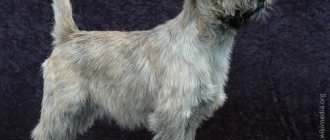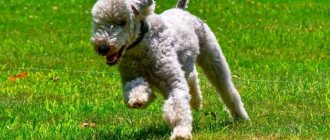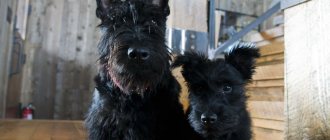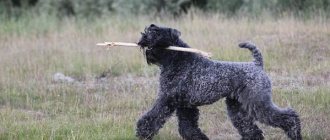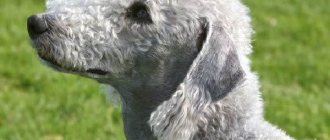The Toy Terrier is a cute little dog that will become your companion and best friend.
These dogs are distinguished by their devotion. They feel your mood and try to adapt to it.
Pocket sizes allow them to be kept in small apartments. Toy terrier puppies require constant care and attention.
The first month is the most difficult and responsible period in their life. Newborn puppies are very vulnerable.
When they are born (and after 15–20 days), their characteristics are blindness, deafness, drooping ears and a disturbed thermoregulation system.
Adult pet weight
An adult dog weighs about 3 kg.
Sometimes there are mini toys weighing 0.9-1 kg. This weight is considered normal for a boy.
But if you are going to breed puppies, the Toya girl must weigh more than 1.8 kg for gestation and birth without complications.
More often 1-3 puppies are born . Their weight is 70-170 grams, which is a lot for such a small dog.
Puppy weight and height by month
The table is indicative. A discrepancy of ±300-400 g is possible. It is worth examining the dog if the weight differs from the table by 1 kg.
Puppies grow disproportionately: in one month they gain a lot, and in the next month the weight will not change . Focus on the condition of the toy. If he is active, playful and eats well, then everything is fine.
The conventional concept of norm also applies to growth.
Puppies are sold at approximately 3 months . At this moment their height is 15-20 centimeters.
The standard toy will grow even bigger by 6-9 months, but the mini toy will no longer be there.
Weight table:
Growth chart:
Video “Dog measurements for sewing clothes”
From this video you will learn how to measure the size of a dog for sewing clothes.
Similar article: The main differences between the miniature pinscher and the toy terrier
Recommended Posts
Weight of a puppy and an adult Labrador by month
Weight and height of a German Shepherd puppy by month
TOP 40 best hunting dog breeds with names, descriptions and photos
38 best dog breeds for apartments according to reviews from breeders and owners
The best hunting helpers: TOP-30 hound dog breeds with names and photos
Standard height and weight of the Cane Corso breed by month
Mini toy terrier
There is no separate standard for this breed . Mini toy terriers are usually classified as dogs whose sizes are smaller than standard ones.
The weight of an adult dog is less than 1.5 kg, the height at the withers is about 20 cm.
Mini Toy Terrier females are not allowed to give birth.
The mini toy is no different in character from the standard one. But it requires a more careful attitude. They break limbs much more often, and if they play carelessly, they can twist their jaw.
There are advertisements for the sale of super mini toy terriers . The weight of such dogs is up to 1.3 kg.
approximate cost
To purchase an animal, you can contact a toy terrier nursery. The range in prices for these dogs is great. Females are much more expensive than males.
Data on how much the average puppy will cost is shown in the table below.
Dynamics of prices for toy terrier puppies (thousand rubles).
| Normal size | Mini puppies | ||||
| Quality | Cable | Female | Cable | Female | |
| "Pat" | From 10 to 13 | From 15 to 18 | From 12 to 18 | From 15 to 20 | |
| "Brid" | From 18 to 25 | From 25 to 35 | From 25 to 35 | From 27 to 35 | |
| "Show" | From 40 to 70 | From 40 to 90 | From 40 to 90 | From 40 to 90 | |
The high cost is explained by the large monetary and time costs of breeders.
Breeding purebred puppies requires considerable investment:
- veterinarian services;
- time to study and communicate with kids;
- healthy diet;
- vaccinations;
- medications that protect against parasites;
- bowls and dog toys, etc.
When purchasing a toy terrier, be prepared to become his real parents.
When is a dog considered an adult?
Decorative breeds develop faster than others.
A dog is considered an adult when its period of physical development ceases.
This usually occurs at 6-9 months in a standard breed, 4-5 in a mini toy terrier..
Mental development ends at 4-5 months. Therefore, puppies are trained from a very early age.
Signs of an adult dog:
- eyes are clean, clear, without clouding;
- baby teeth were replaced by permanent ones;
- the dog’s body is toned, strong, proportional; height does not change, but weight may increase.
Photo gallery
If you have purchased a toy terrier puppy, it means that you have a devoted friend who needs your constant care. And if you have not yet decided on the choice of breed, let's look at the photos of these small pocket dogs.
Parameters of an adult toy terrier
Boys and girls of toy terriers are almost no different from each other in appearance. In some breeds, boys are more impressive and larger, but toys do not have this feature.
The height of an adult animal is up to 28 cm, anything higher does not fit into the breed standard:
According to the format, terriers are square.
For this format, the following characteristics apply::
- The oblique length of the body is equal to the height at the withers. Oblique length - from the extreme point of the chest to the sit bones. Height at the withers - from the ground to the withers.
- The back-lumbar-croup ratio is 2:1:1. If we conditionally divide the length of the dog (from the base of the neck to the beginning of the tail) in half, then the part at the neck is the back. Then comes the loin, followed by the croup.
- The height of the limbs is slightly more than half the height at the withers.
Factors influencing performance
Growth and development depend on proper nutrition. The diet should contain minerals and vitamins, especially calcium, and healthy fats.
Decide on the type of food - natural or food. Mixed nutrition is undesirable.
It is better to feed your puppy on a schedule:
- 1.5 – 3 months: 4 times a day;
- 2 – 4 months: 3 times a day;
- 4 – 6 months: 2 times a day.
Serving size for 3-4 meals a day is about 30 g. You cannot overfeed, otherwise excess weight will form.
Calcium and phosphorus are essential for strong bones and teeth . A calcium deficiency is indicated by the toy's ears. If they first rose and then hung, the puppy needs vitamins. Multivitamins should be introduced into the diet gradually, monitoring the pet’s health.
The puppy is taken for vaccination. The first vaccination is given at approximately 6 weeks .
This prepares the body for the next dose. The next vaccination is given at 2.5 months, it will protect the body from diseases - distemper, hepatitis, etc. If the puppy suffers some kind of disease, the consequences are irreversible.
Choosing a baby
To choose your future pet, follow these recommendations:
Pay attention to the habits, character, and appearance of the kitten. The eyes, nose and ears should be clean. Any discharge indicates poor health.
The coat should be shiny and smooth. In the anal area there are no signs of loose stool.
Call them, the first one to respond will be the kindest. Loyalty is unlikely to be his trait; rather, an affectionate attitude will be manifested on his part towards everyone around him.
Consider deviations from developmental standards (weight, height, color). This is how much a kitten should weigh approximately:
| Age | Weight |
| 1 month | 200–650 gr. |
| 2 months | 320–1050 gr. |
| 3 months | 460–1550 gr. |
| 4 months | 600–900 gr. |
| 5 months | 700–2200 gr. |
| 6 months | 800–2500 gr. |
When purchasing a pet for exhibition purposes, you should immediately pay attention to all the subtleties required for toy terriers.
Check out the documentation and pedigree. And also specify how many times vaccination was carried out.
Lack of weight: what to do?
Being underweight is no less dangerous than being overweight. Check the puppy weight chart by month.
If the ribs and spine of the toy terrier are noticeable even without palpation, then the dog is unhealthy thin.
If the puppy has stopped gaining weight, it is recommended:
- Give the puppy anti-helminth medications. When parasites are inside an animal, they prevent nutrients from being absorbed and suck them out themselves.
- Try giving your puppy more exercise. Play with him more often, take him for a walk.
- Increase the portion. Or increase the number of meals.
- Read the composition of the food. Meat ingredients should come first, not cereals. Buy food from the premium segment, marked “for puppies”.
- Contact your veterinarian. Weight loss is a symptom of diseases, such as hepatitis, cancer or inflammatory processes in organs.
Causes of excess weight
We now know how much an average toy terrier should weigh. Now it’s worth talking about what could cause extra pounds, since they will definitely affect not only the behavior, but also the health of the pet. The following factors contribute to obesity:
- inactive lifestyle;
- disruptions in the activity of the nervous system;
- improper functioning of the glands of the endocrine system.
But first of all, the number of kilograms in a dog’s body depends on what it eats. A four-legged friend should have a balanced diet and a clear feeding schedule. Do not feed your toy sweets. The Russian Toy Terrier's menu includes meat, cereals, dairy products, vegetables and fruits. If your dog has already grown too big, then put him on a diet low in fat and carbohydrates. In this case, it is recommended to increase physical activity and walk outside longer.
Excess weight: causes and treatment
When a Toy Terrier becomes overweight, the stress on fragile bones increases . The risk of heart and liver diseases increases. The risk of diabetes increases.
Examine the dog yourself. While standing, feel the sides and back of the animal. If the ribs and spine are weak or cannot be felt at all, then the toy is overweight.
Constipation, excessive sweating and shortness of breath also indicate excess weight..
Causes of obesity:
- Poor nutrition. Overeating is unacceptable. Toys may not feel the measure. Limit access to food, introduce 2 meals a day.
- Sedentary lifestyle. Even if the dog goes to the tray or on a diaper, arrange walks in the air.
- Malfunctions of the body.
What to do:
- Consult your veterinarian. If a disease is detected, he will prescribe a course of treatment.
- Stick to your diet. Do not feed toy from the table, reduce the portion size. Change the food to something special for overweight dogs.
- Increase your physical activity. Play with your dog, buy toys. Go for walks regularly. If you have a lot of excess weight, start gradually. At first, just walk 30 minutes a day. When the dog becomes easier, introduce running and games.
You will need to enter the dog’s parameters, activity level and find out the number. The calorie content of one serving is usually indicated on the package; if eating natural foods, calculate the number of calories manually, for example, using a mobile application and scales.
Meeting height and weight standards is required to participate in shows . If you don’t plan to visit them, then don’t exhaust your dog in pursuit of the ideal. The most important thing for a toy terrier is the care of the owner.
Follow the basic rules - meals 2 times a day, no handouts from the table, physical activity and regular monitoring by a veterinarian.
Read more detailed information about caring for a toy terrier here.
Diseases
It is important to immediately point out an interesting detail: if you pay attention to the dog’s needs and care for him properly, he will almost never be sick. The most vulnerable areas of a toy terrier are the eyes, bones and teeth. At about six months, the dog loses its milk teeth, which are replaced with molars.
But the difficulty may be that the milk ones will turn out to be “lazy” and will not fall out on their own. And the indigenous people, meanwhile, will make their way. Thus, there is a risk of the formation of so-called “double” teeth. In this case, surgical intervention will be required.
The Toy Terrier is an intelligent and loyal breed of dog.
These miniature four-legged comrades also suffer from such a scourge as tartar. This nuisance, by the way, is common to all breeds with a height of less than 35 cm. Tartar provokes tooth loss, so caring for them must begin with young claws.
In addition, you should pay close attention to the dog’s physical activity. This fragile little girl has a very high risk of developing a fracture or dislocation of her knee, so it is important that the dog does not jump from a height that exceeds his own height. When in contact with other dogs, a toy terrier can unexpectedly show its fighting spirit, which is fraught with not the most rosy consequences.
In this case, you should be on your guard in advance. Typical eye diseases in this breed include retinal atrophy in old age and cataracts. Both cases require medical, if not surgical, intervention. Finally, it is worth noting that the dog is prone to colds. We are not talking about the owners wrapping up their pets, but it still makes sense to dress them warmly in cold weather.
Stages of development
It is very important for any dog owner to know the correct rate and duration of growth of the pet, as well as how the proportions change in each individual time period.
Until what age is a dog considered a puppy? Here are the main stages of dog development:
- embryonic (while the embryo is in the womb);
- suckling (begins immediately after birth and lasts approximately 30-45 days);
- puppies (from one and a half months to six months);
- young animals (from six months to a year);
- young individuals (from one to two and a half years).
Attention! The most important foundations are laid during the prenatal period and during feeding.
At this time, the greatest acceleration of growth occurs. For example, the weight of an embryo on the fortieth day of a mother’s pregnancy can be about several grams, while a puppy emerges with a weight of 300g or more. up to 600g. In total, we have an increase in weight literally hundreds of times.
After birth, within a month, the cub increases its weight approximately five to six times.
At this age, the puppy already has all the typical signs of its breed, appearance, proportionality of the skull, ears, coat color, as well as bright constitutional features characteristic of the breed.
Males and females also differ in appearance. When the puppy reaches one month, the baby is weaned from mother's milk.
After three months, the growth rate decreases, although it remains at a fairly high level. And upon reaching the age of 6 months, the pet can no longer be considered a puppy, but transferred to the conditional category “young animals”.
Height and weight standard
1 month
By the end of the first 30 days of life, the baby should weigh from 200 to 650 g. It all depends on the size of the toy. If the puppy’s body weight exceeds the norm by 150 g, there is no need to worry and put the growing “child” on a diet.
We recommend this article:
The best nicknames for toy terriers boys and girls
2 month
At two months of age, puppies should increase their body weight to 1050 g - this is the maximum. The minimum weight of a healthy dog is 320 g.
We recommend this article:
How to quickly accustom a toy terrier to a tray or diaper
3 month
After another 30 days, the dog becomes heavier by another half kilogram if he has the upper mass indicators; and 140 grams, if lower. At this age, the weight of a toy terrier, according to the table, cannot be less than 460 and more than 1550 g.
We recommend this article:
Rules for preparing and vaccinating Toy Terrier puppies
4 month
At 4 months, babies weighing 600 g are considered quite healthy and well-fed, and large representatives of the breed can have a body weight of 1.9 kg.
We recommend this article:
Cropping and setting of ears in toy terriers
5 month
Already at 5 months, the toy’s weight indicators are approaching the maximum mark, although the dog will still grow and develop for at least a year. So, five-month-old terriers can weigh from 700 g to 2.2 kg.
Similar article: History of origin and description of the Fox Terrier breed
6 month
A six-month-old toy can already have the weight of an adult dog, which ranges from 800 g to 2.5 kg. But don't panic if your toy terrier's measurements differ from those in the table. Not all dogs of this breed grow up to 1.5 years; the growth of some stops already at the age of five months, and accordingly the dog will not gain much weight. Therefore, to clearly answer the question “Until what age does the Russian Toy Terrier grow?” difficult.
We recommend this article:
Independent education and training of a toy terrier
Observe your baby's behavior. A pet should be cheerful, cheerful and very active. If all of this applies to your pet, but its dimensions are different from those indicated in this article, do not worry, everything is fine with it.
What to feed a puppy for growth?
A balanced and properly formulated diet is of greatest importance. It is better to draw up a feeding regimen together with a specialist. It is imperative to take into account the characteristics of the breed, size and physiology.
In the period from one and a half to three months, the puppy needs quite frequent feeding: about six times a day. Gradually, the number of feedings should be reduced to four, and after two months to three times.
When the puppy reaches six months, he is transferred to two feedings a day, morning and evening.
It is worth noting that after six months, puppies are actively gaining muscle mass, so they need sufficient amounts of protein, calcium and vitamins.
So, for 1 kg of weight you need:
- nine grams of protein;
- two and a half grams of fat;
- fourteen grams of sugar and starch;
- one and a half grams of fiber;
- five hundred milligrams of calcium;
- as well as vitamins A, D and E.
What to feed a puppy for growth? There are two types of feeding: natural food and factory feed.
Pet food at the premium level and above has quite great advantages. For example, they contain all the necessary macro- and microelements, vitamins, and are fully balanced for a specific breed, age and characteristics of the dog.
If the puppy eats natural food, then follow the general recommendations.
Important! Salty, smoked, fatty, and spicy foods are prohibited for dogs.
Raw meat is given with caution, as it may be contaminated with helminths. You should completely exclude flour, sausages and various sweets from your diet!
All this is poison for the dog’s gastrointestinal tract. Her teeth may become damaged and her eyes will water. Small bones that can pierce the esophagus or stomach are dangerous.
It is recommended to adhere to a certain feeding schedule and accustom the puppy to it from a very early age.
It is extremely important to meet your dog's water needs. So, for one kilogram of weight you need to give from forty to one hundred milliliters of water.
A properly balanced diet and sufficient intake of minerals even affects the development of the dog’s skeleton. A tendency to pathology of the skeletal system is more common in large breed dogs, such as the German Shepherd, St. Bernard, and Labrador Retriever.
Thus, scientists studied the effect of nutrition on the growth process and identified two main factors:
- overfeeding;
- excessive calcium intake.
It follows from this: it is extremely important to maintain a balance of this mineral in food, since an increase in the rate of calcium intake causes deviations in cartilage tissue, and a reduced intake increases the risks of developing a weak skeleton and an increase in the incidence of fractures.
Breed characteristics and character
The Toy Terrier also has a more modern name “Russian Toy”. It belongs to the decorative breed, and breeders distinguish between smooth-haired and long-haired dogs. It is interesting that these four-legged miniature friends were bred in the capital of our Motherland.
Brown toy terrier
The Toy Terrier breed was obtained in Moscow. The history goes back to the beginning of the last century, when English toy terriers were at the peak of popularity in Tsarist Russia. However, the popularity of that breed did not last long.
After the 20s of the twentieth century, they were practically not bred in connection with the October Revolution. After all, these cute dogs were a symbol of the aristocracy, and therefore were not approved by the Bolsheviks. Their number began to decrease exponentially, but already in the middle of the twentieth century, cynologists appeared who decided to recreate the breed, however, this time in the Russian way.
As a result, thanks to selection, smooth-haired individuals were obtained, and after an experiment with crossing two smooth-haired parents, the first long-haired Russian Toy was obtained.
This canine micro-individual is distinguished not only by its great agility, but also by its endurance. The Toy Terrier dog is very devoted to its owners and easily makes contact with children, being sociable and active. The toy terrier's friendliness knows no bounds - he enjoys both people and other animals.
Toy Terriers are easy to train
The size of the toy terrier is such that it gives the false impression of a modest, cowardly dog, but, despite its miniature appearance, the dog has qualities characteristic of large dogs - balance and trainability, so the appearance of the pet should not deceive the future owner.
In addition, this baby has a unique ability to be cunning, so training such a dog is mandatory, and you need to start training as early as possible, otherwise after two years it will be too late. A toy terrier, deprived of attention, becomes embittered, and over the years this quality only progresses. This is the property of his psyche, which is not very stable.
When does a toy terrier stop growing?
Dogs that are small breeds grow very quickly. The rapid development in growth ends from five to nine months. A more precise definition depends on the breed and personality of each individual. Basically, active growth and development of puppies occurs up to six months. Large breed dogs continue to grow and develop after a year, although the growth rate is much lower.
The health of the future puppy begins inside the mother's womb. Responsibility for the growth and development of the baby after birth falls on the breeders. So, the baby should be taken from healthy parents of this breed and a responsible breeder.
Well, then you take a puppy and, as a new owner, are responsible for it.
The first six months of a four-legged friend’s life are characterized not only by an increase in height and weight, but also by a change of teeth. At the same time, tubular bones grow and are finally formed, the correct development of which affects the proportions of the animal’s body.
After six months, the toy's growth begins to slow down, and he still gains weight. The period of up to a year is characterized by intensive development of the chest, as active growth of flat bones occurs.
How long does it take for mini toy terriers to grow?
You will be surprised how many months it takes toy terriers to grow, including mini toy terriers. The accelerated growth of a miniature dog stops at four to five months. It is worth noting that as a puppy grows, its brain activity also develops actively. A four-month-old toy terrier puppy is not inferior in mental development to an adult.
Let us immediately make a reservation that these data are averaged, since the growth and formation of the animal is significantly influenced by the dog’s diet, the conditions in which it is kept, its care, training and education. Special attention should be paid to proper nutrition during the period of growing up and the formation of the body and ensure that proteins and vitamins are present in food. Excessive loads during training or, conversely, a sedentary lifestyle of the terrier contribute to the destruction of bone tissue that has not yet fully formed, which will subsequently lead to diseases of the musculoskeletal system.
But first of all, normal development, including growth, is possible only in the absence of genetic predispositions to diseases.
Nutrition
Many nuances arise in the process of nutrition. The digestive system of the cutie is very weak. Therefore, you should think through your diet especially carefully.
Improper preparation of food in violation of the norms of nutrients contained can lead to indigestion, liver disease and even death.
Therefore, it is better to buy special food for toy terrier puppies. Moreover, preference should be given to more expensive, reliable companies.
If you decide to cook your own food, you will always need to feed your babies only this kind of food.
If you choose ready-made food, you exclude homemade food. Mixed nutrition is unacceptable. Special fertilizers should be carefully added to food. Excess vitamins can cause stomach dysfunction or an allergic reaction.
